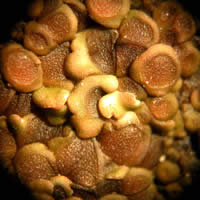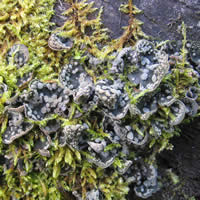USDA Forest Service Celebrating Wildflowers
|
|
|
 |
|
Lichen BiologyReproduction
Can you imagine how two different species living in the same body reproduce? We know that to reproduce, we need to have two of the same species to produce fertile offspring. Lichens are unique in that they are composed of two (or more) different species, or in fact, kingdoms. Lichens are different. Unlike plants that can produce seeds that grow into new plants, lichens do not have a straightforward way to grow more lichen. Since the fungus is the dominant partner in the relationship, it gets to develop its fruiting bodies and produce spores. These spores can produce another fungus, but unfortunately, for the alga, it does not get the opportunity to reproduce at all. Either the new fungus has to find an algal partner or it perishes. Of course, evolution must go on, and lichens have adapted to their bi-specific struggle. These organisms can vegetatively reproduce; that is, they have structures specifically developed for the spread of fragments of their thalli, with both partners. Not only are there specific vegetative structures, but simple fragments of lichen can grow into full-size thalli. |
|
| NOTE: PDF format links require the Adobe Acrobat Reader to view. | |
| top | Disclaimers | FOIA | Privacy Policy | Quality of Information | Photo Credits & Use |
Location: http://www.fs.fed.us/wildflowers/interesting/lichens/biology/reproduction.shtml
Last modified: Tuesday, 24-Jun-2008 21:54:31 EDT

